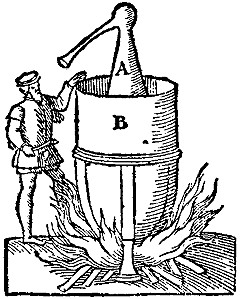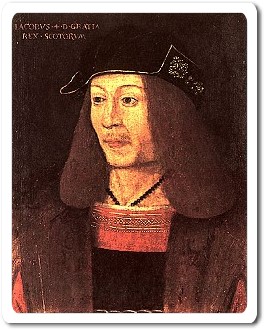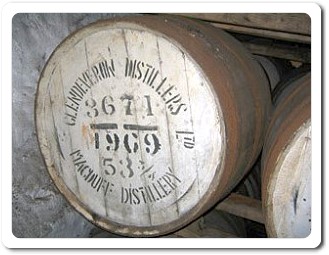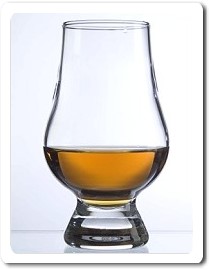
 The
Gaelic "usquebaugh", meaning "Water of Life",
phonetically became "usky" and then "whisky"
in English. However it is known, Scotch Whisky, Scotch or
Whisky (as opposed to whiskey), it has captivated a global
market. The
Gaelic "usquebaugh", meaning "Water of Life",
phonetically became "usky" and then "whisky"
in English. However it is known, Scotch Whisky, Scotch or
Whisky (as opposed to whiskey), it has captivated a global
market.
Scotland has internationally protected the term "Scotch".
For a whisky to be labelled Scotch it has to be produced in
Scotland. If it is to be called Scotch, it cannot be produced
in England, Wales, Ireland, America or anywhere else. Excellent
whiskies are made by similar methods in other countries, notably
Japan, but they cannot be called Scotches. They are most often
referred to as "whiskey". While they might be splendid
whiskies, they do not captivate the tastes of Scotland.
"Eight bolls of malt to Friar John Cor wherewith
to make aqua vitae"
The entry above appeared in the Exchequer Rolls as long ago
as 1494 and appears to be the earliest documented record of
distilling in Scotland. This was sufficient to produce almost
1500 bottles, and it becomes clear that distilling was already
a well-established practice.
Legend would have it that St Patrick introduced distilling
to Ireland in the fifth century AD and that the secrets traveled
with the Dalriadic Scots when they arrived in Kintyre around
AD500. St Patrick acquired the knowledge in Spain and France,
countries that might have known the art of distilling at that
time.
The distilling process was originally applied to perfume,
then to wine, and finally adapted to fermented mashes of cereals
in countries where grapes were not plentiful. The spirit was
universally termed aqua vitae ('water of life') and was commonly
made in monasteries, and chiefly used for medicinal purposes,
being prescribed for the preservation of health, the prolongation
of life, and for the relief of colic, palsy and even smallpox.
There were monastic distilleries in Ireland in the late-12th
century.
 |
| King James IV (1488-1513) |
Scotland's great Renaissance king, James IV (1488-1513) was
fond of 'ardent spirits'. When the king visited Dundee in 1506,
the treasury accounts record a payment to the local barber for
a supply of aqua vitae for the king's pleasure. The reference
to the barber is not surprising. In 1505, the Guild of Surgeon
Barbers in Edinburgh was granted a monopoly over the manufacture
of aqua vitae - a fact that reflects the spirits perceived medicinal
properties as well as the medicinal talents of the barbers.
The primitive equipment used at the time and the lack of scientific
expertise meant that the spirit produced in those days was probably
potent, and occasionally even harmful. During the course of
the 15th century, along with better still design, the dissolution
of the monasteries contributed to an improvement in the quality
of the spirits produced. Many of the monks, driven from their
sanctuaries, had no choice but to put their distilling skills
to use. The knowledge of distilling then quickly spread to others.
The increasing popularity eventually attracted the attention
of the Scottish parliament, which introduced the first taxes
on malt and the end product in the latter part of the 17th century.
Ever increasing rates of taxation were applied following The
Act of Union with England in 1707, when England set out to tame
the rebellious clans of Scotland. The distillers were driven
underground.
A long and often bloody battle arose between the excisemen,
or gaugers, as they were known, and the illicit distillers,
for whom the excise laws were alien in both their language and
their inhibiting intent. Smuggling became standard practice
for some 150 years and there was no moral stigma attached to
it. Ministers of the Kirk made storage space available under
the pulpit, and the illicit spirit was, on occasion, transported
by coffin - any effective means was used to escape the watchful
eyes of the Excise men.
Clandestine stills were cleverly organised and hidden in nooks
and crannies of the heather-clad hills, and smugglers organised
signaling systems from one hilltop to another whenever excise
officers were seen to arrive in the vicinity. By the 1820s,
despite the fact that as many as 14,000 illicit stills were
being confiscated every year, more than half the whisky consumed
in Scotland was being swallowed painlessly and with pleasure,
without contributing a penny in duty.
 This
flouting of the law eventually prompted the Duke of Gordon,
on whose extensive acres some of the finest illicit whisky in
Scotland was being produced, to propose in the House of Lords
that the Government should make it profitable to produce whisky
legally. This
flouting of the law eventually prompted the Duke of Gordon,
on whose extensive acres some of the finest illicit whisky in
Scotland was being produced, to propose in the House of Lords
that the Government should make it profitable to produce whisky
legally.
In 1823 the Excise Act was passed, which sanctioned the distilling
of whisky in return for a license fee of £10, and a set
payment per gallon of proof spirit. Smuggling died out almost
completely over the next ten years and, in fact, a great many
of the present day distilleries stand on sites used by smugglers
of old.
The Excise Act laid the foundations for the Scotch Whisky
industry, as we know it today. However, two further developments
put Scotch Whisky on firmly on the world map.
 Until
now, we have been talking about what we now know as Malt Whisky.
But, in 1831 Aeneas Coffey invented the Coffey or Patent Still,
which enabled a continuous process of distillation to take place.
This led to the production of Grain Whisky, a different, less
intense spirit than the Malt Whisky produced in the distinctive
copper pot stills. The lighter flavored Grain Whisky, when blended
with the more fiery malts, extended the appeal of Scotch Whisky
to a considerably wider market. Until
now, we have been talking about what we now know as Malt Whisky.
But, in 1831 Aeneas Coffey invented the Coffey or Patent Still,
which enabled a continuous process of distillation to take place.
This led to the production of Grain Whisky, a different, less
intense spirit than the Malt Whisky produced in the distinctive
copper pot stills. The lighter flavored Grain Whisky, when blended
with the more fiery malts, extended the appeal of Scotch Whisky
to a considerably wider market.
The second major helping hand came unwittingly from France.
By the 1880s, the phylloxera beetle had devastated the vineyards
of France, and within a few years, wine and brandy had virtually
disappeared from cellars everywhere. The Scots were quick to
take advantage of the calamity, and by the time the French industry
recovered, Scotch Whisky had replaced brandy as the preferred
spirit of choice.
Since then Scotch Whisky has survived. It has survived Prohibition,
wars and revolutions, economic depressions and recessions, to
maintain its position today as the international spirit of choice,
extending to more than 200 countries throughout the world.
|

